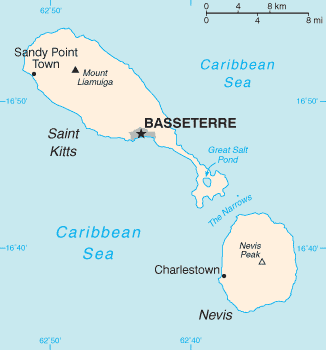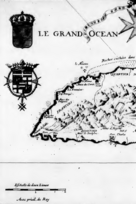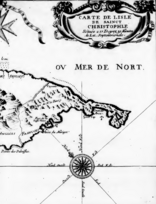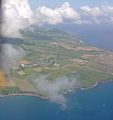Saint Kitts facts for kids

Map showing Saint Kitts and Nevis
|
|
 |
|
| Geography | |
|---|---|
| Location | Caribbean Sea |
| Coordinates | 17°19′N 62°43′W / 17.31°N 62.72°W |
| Archipelago | Leeward Islands |
| Total islands | 8 |
| Major islands | 2 |
| Area | 174 km2 (67 sq mi) |
| Length | 29 km (18 mi) |
| Width | 8 km (5 mi) |
| Highest elevation | 1,156 m (3,793 ft) |
| Highest point | Mount Liamuiga |
| Administration | |
| 2 divisions of Saint Kitts | |
| Largest settlement | Basseterre (pop. 15,500) |
| Demographics | |
| Population | 34,983 (2011) |
| Pop. density | 208.33 /km2 (539.57 /sq mi) |
| Ethnic groups | African descent, Indian, British, Portuguese, Lebanese |
Saint Kitts, also known as Saint Christopher Island, is a beautiful island in the Caribbean. Its west side touches the Caribbean Sea, while its eastern coast faces the Atlantic Ocean. Saint Kitts and the nearby island of Nevis form one country called the Federation of Saint Kitts and Nevis. These two islands are separated by a shallow channel, about 3 kilometers wide, known as "The Narrows".
Saint Kitts was one of the first places in the Caribbean where British and French colonies were started in the 1620s. Along with Nevis, Saint Kitts was part of the British West Indies until it became an independent country on September 19, 1983.
The island is part of the Leeward Islands in the Lesser Antilles. It is located about 2100 kilometers southeast of Miami, Florida, USA. Saint Kitts covers about 168 square kilometers. It is about 29 kilometers long and usually about 8 kilometers wide.
Saint Kitts has a population of around 40,000 people. Most of them are of African descent. The main language spoken is English, and almost everyone can read and write. People who live on the island are called Kittitians.
The Brimstone Hill Fortress National Park is a UNESCO World Heritage Site. It is the largest fortress ever built in the Western Caribbean. Saint Kitts is also home to the Warner Park Cricket Stadium. This stadium hosted matches for the 2007 Cricket World Cup. This made Saint Kitts and Nevis the smallest country to ever host a World Cup event. Saint Kitts also has several universities, including Ross University School of Veterinary Medicine and Windsor University School of Medicine.
Contents
Island Geography
The capital city of Saint Kitts and Nevis is Basseterre, which is also the largest port. It is located on Saint Kitts. Basseterre has a modern port that can handle large cruise ships. A main road circles the island, and smaller roads branch off from it. The middle of the island is too steep for people to live there.
Saint Kitts is about 10 kilometers north of Sint Eustatius and 3 kilometers south of Nevis. Saint Kitts has three groups of volcanic peaks. The highest peak is Mount Liamuiga, which used to be called Mount Misery. It is a sleeping volcano that is 1,156 meters high.
Island Geology
Mount Liamuiga is the youngest volcano on the island. It is about 5 kilometers wide and rises to 1155 meters. Its last eruption was about 1620 years ago. This volcano has a large crater, 900 meters wide and 244 meters deep. It also has two smaller domes, Brimstone Hill and Sandy Point Hill. Brimstone Hill is special because it has limestone on its sides.
Island History
During the last ice age, the sea level was much lower. At that time, St. Kitts and Nevis were one large island, connected to Saba and Sint Eustatius.
Saint Kitts was first settled by "Archaic people" who did not farm or use pottery. They came from Florida. Later, around 100 BC, the Saladoid people arrived. They used pottery and were farmers. They came from the Orinoco River in Venezuela. Around 800 AD, the Igneri people, who were part of the Arawak group, took their place.
Around 1300 AD, the Kalinago people, also known as Caribs, arrived. They were farmers and quickly spread out, pushing the Igneri people north. They named Saint Kitts "Liamuiga," which means "fertile island."
A Spanish expedition led by Christopher Columbus arrived in 1493 and claimed the island for Spain.
The first English colony was started in 1623, and a French colony followed in 1625. The English and French worked together for a short time to deal with the local Kalinago people. Then, they divided the island. The English colonists lived in the middle, and the French lived on either end. In 1629, a Spanish force took control of St. Kitts. The English settlement was rebuilt after a peace agreement between England and Spain in 1630.
The island often switched between English (later British) and French control during the 17th and 18th centuries. One power would take the whole island, only for it to change hands again because of treaties or battles. Parts of the island were strongly protected, like the UNESCO World Heritage Site at Brimstone Hill and the old Fort Charles.
Since 1783, Saint Kitts has been connected to the Kingdom of Great Britain, which later became the United Kingdom.
End of Slavery
The island first grew tobacco. But in 1640, it switched to growing sugar cane because of strong competition from the colony of Virginia. Growing sugar cane needed a lot of workers. This led to many people from Africa being brought to the island as slaves. This practice began soon after Europeans arrived in the region.
Buying enslaved Africans was made illegal in the British Empire by a law in 1807. Slavery itself was ended by a law that became effective on August 1, 1834. This freedom was followed by four years where former slaves had to continue working for their previous owners. This was done to help the plantation owners.
August 1 is now a public holiday called Emancipation Day. In 1883, Saint Kitts, Nevis, and Anguilla were all put under one government, located on Saint Kitts. This made the people of Nevis and Anguilla unhappy. Anguilla eventually separated from this arrangement in 1971.
Sugar production was the main part of the local economy until 2005. After 365 years of relying on only one crop, the government closed the sugar industry. This happened because of big financial losses and plans by the European Union to greatly lower sugar prices.
Government and Parishes
For governing purposes, the island is divided into nine areas called parishes:
- Christ Church Nichola Town
- Saint Anne Sandy Point
- Saint George Basseterre
- Saint John Capisterre
- Saint Mary Cayon
- Saint Paul Capisterre
- Saint Peter Basseterre
- Saint Thomas Middle Island
- Trinity Palmetto Point
Island Economy
Saint Kitts and Nevis uses the Eastern Caribbean dollar. This currency has a fixed exchange rate with the United States dollar, meaning 2.7 Eastern Caribbean dollars are equal to one US dollar. The US dollar is also widely accepted on the island.
For hundreds of years, Saint Kitts relied only on sugar production. But because it became less profitable, the government closed the sugar industry in 2005. Tourism is now a very important and growing source of money for the island. Other growing parts of the economy include transportation, farming (not sugar), manufacturing, and construction.
Saint Kitts depends on tourism to help its economy grow. Tourism has been increasing since 1978. In 2009, 587,479 visitors came to Saint Kitts. This was a big increase from 379,473 visitors in 2007. As tourism grows, more people want to buy vacation homes on the island.
Saint Kitts and Nevis also gets money from foreign investors through its special citizenship by investment program. People can become citizens if they pass strict background checks and invest in approved real estate projects. For example, if someone invests at least US$400,000 in a government-approved real estate project and passes checks, they can apply for citizenship.
The country also hosts an annual St. Kitts Music Festival.
Getting Around Saint Kitts
Robert L. Bradshaw International Airport serves Saint Kitts. You can find daily flights from cities like Charlotte, Miami, and New York.
The Basseterre Ferry Terminal makes it easy to travel between Saint Kitts and its sister island, Nevis.
The narrow-gauge St. Kitts Scenic Railway goes around the island. It offers rides for passengers from its main station near the airport. This service is mostly for tourists, not for daily travel by residents. The railway was built between 1912 and 1926 to carry sugar cane from farms to the sugar factory in Basseterre. Since 2003, it has offered a 3.5-hour, 30-mile tour of the island on special double-decker open-air coaches. About 12 miles of the trip are by bus. The scenic railway now gives tourists and even citizens a chance to see beautiful views of the island.
Famous People from Saint Kitts
Many notable people have lived in or are from Saint Kitts:
- Joan Armatrading: A British singer-songwriter.
- Imruh Bakari: A film maker and writer.
- Hutchens C. Bishop: A clergyman who led a protest parade in New York in 1917.
- Robert Bradshaw: The first Premier of Saint Kitts and Nevis.
- Archibald Burt: The first Chief Justice of Western Australia.
- Burt Caesar: An actor, broadcaster, and director.
- Pogus Caesar: A British artist, television producer, and director.
- Kim Collins: A former world champion sprinter (2003).
- Felix Dexter: An actor, comedian, and writer.
- Pavel Durov: The founder of Telegram.
- Bertil Fox: A professional bodybuilder.
- James Grainger: A doctor and planter who wrote a poem about sugar cane.
- Keith Gumbs: An international football player.
- Sir James Harford: Administrator of Saint Christopher from 1940 to 1946.
- Atiba Harris: A Kittitian footballer who plays for FC Dallas.
- Virgil Hodge: A female sprinter.
- Konris Maynard: A Calypso musician and politician.
- Major-General Sir Robert Nickle: Governor of Saint Christopher from 1830.
- Caryl Phillips: A novelist, playwright, and essayist.
- Tiandra Ponteen: A female sprinter.
- Marcus Rashford: A professional footballer for Manchester United and England, of Kittitian descent.
- Hercules Robinson, 1st Baron Rosmead: Governor of Saint Christopher from 1855 to 1859.
- Sir Cuthbert Sebastian: Governor-General of St Kitts-Nevis from 1996 to 2012.
- Joseph Matthew Sebastian: A Caribbean trade union leader and politician.
- Shirley Skerrit-Andrew: Former High Commissioner to Canada.
- Julius Soubise: A freed Afro-Caribbean slave who became well-known in the UK.
- Neil Strauss: An American author and journalist.
- Roger Ver: A businessman.
- Desai Williams: A former sprinter who won a bronze medal in the 1984 Olympics.
- Ned Young: A sailor and mutineer from the HMS Bounty incident. He helped found the mutineers' settlement on Pitcairn Island.
- The Hon Dr Timothy Harris: Prime Minister of Saint Kitts and Nevis (2015–present).
Gallery
-
Southeast Peninsula (Saint Kitts). The island on the left is Nevis.
See also
 In Spanish: Isla de San Cristóbal (San Cristóbal y Nieves) para niños
In Spanish: Isla de San Cristóbal (San Cristóbal y Nieves) para niños













